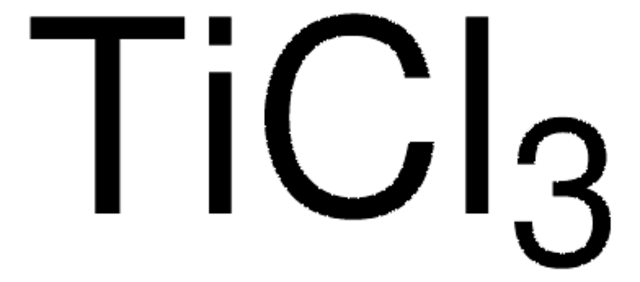推荐产品
方案
≥99.995% trace metals basis
表单
crystalline
反应适用性
reagent type: catalyst
core: titanium
mp
440 °C (dec.) (lit.)
SMILES字符串
Cl[Ti](Cl)Cl
InChI
1S/3ClH.Ti/h3*1H;/q;;;+3/p-3
InChI key
YONPGGFAJWQGJC-UHFFFAOYSA-K
正在寻找类似产品? 访问 产品对比指南
应用
用于气相形成具有超细粒度的金属间化合物。
警示用语:
Danger
危险声明
危险分类
Pyr. Sol. 1 - Skin Corr. 1B
补充剂危害
储存分类代码
4.2 - Pyrophoric and self-heating hazardous materials
WGK
WGK 3
闪点(°F)
Not applicable
闪点(°C)
Not applicable
个人防护装备
Eyeshields, Faceshields, Gloves, type P3 (EN 143) respirator cartridges
Gnana S Siluvai et al.
Biochemistry, 48(51), 12133-12144 (2009-11-20)
Sco-like proteins contain copper bound by two cysteines and a histidine residue. Although their function is still incompletely understood, there is a clear involvement with the assembly of cytochrome oxidases that contain the Cu(A) center in subunit 2, possibly mediating
Jun-ichi Matsuo et al.
Organic letters, 12(14), 3266-3268 (2010-06-24)
N-p-Toluenesulfonyl (Ts) aldimines reacted with 3-ethoxycyclobutanones by catalysis of titanium(IV) chloride to afford 2,3-di- or 2,3,3-trisubstituted N-Ts-2,3-dihydro-4-pyridones. Synthesis of (+/-)-bremazocine was efficiently accomplished by using this method.
L Messori et al.
FEBS letters, 442(2-3), 157-161 (1999-02-03)
The reaction of human serum apotransferrin with titanium(IV) citrate under physiological conditions results in the formation of a specific bis-titanium(IV) transferrin adduct (Ti2Tf hereafter) with two titanium(IV) ions loaded at the iron binding sites. The same specific Ti2Tf complex is
H A Akers et al.
Analytical biochemistry, 154(2), 559-563 (1986-05-01)
Thirteen model alpha-ketocarboxylic acids and alpha-dicarbonyl compounds have been observed to be reduced by titanium(III) chloride. The products of these reactions were shown by melting (boiling) points, mixed melting points, derivatives, refractive indices, infrared, and NMR comparisons with authentic compounds
Palaniappan Kulanthaivel et al.
Drug metabolism and disposition: the biological fate of chemicals, 32(9), 966-972 (2004-08-21)
Phase I oxidative metabolism of nitrogen-containing drug molecules to their corresponding N-oxides is a common occurrence. There are instances where liquid chromatography/tandem mass spectometry techniques are inadequate to distinguish this pathway from other oxidation processes, including C-hydroxylations and other heteroatom
Active Filters
我们的科学家团队拥有各种研究领域经验,包括生命科学、材料科学、化学合成、色谱、分析及许多其他领域.
联系客户支持










